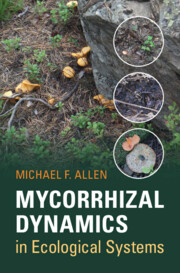Book contents
- Mycorrhizal Dynamics in Ecological Systems
- Mycorrhizal Dynamics in Ecological Systems
- Copyright page
- Contents
- Preface
- Acknowledgments
- Glossary of Key Terms
- 1 Introduction
- 2 Structure–Functioning Relationships
- 3 Evolutionary Ecology
- 4 Physiological Ecology
- 5 Population Ecology
- 6 Community Ecology
- 7 Ecosystem Dynamics
- 8 Mycorrhizae and Succession
- 9 Global Change
- 10 Conservation, Restoration, and Re-wilding
- 11 Conclusion and Summary
- Bibliography
- Index
9 - Global Change
Published online by Cambridge University Press: 25 March 2022
- Mycorrhizal Dynamics in Ecological Systems
- Mycorrhizal Dynamics in Ecological Systems
- Copyright page
- Contents
- Preface
- Acknowledgments
- Glossary of Key Terms
- 1 Introduction
- 2 Structure–Functioning Relationships
- 3 Evolutionary Ecology
- 4 Physiological Ecology
- 5 Population Ecology
- 6 Community Ecology
- 7 Ecosystem Dynamics
- 8 Mycorrhizae and Succession
- 9 Global Change
- 10 Conservation, Restoration, and Re-wilding
- 11 Conclusion and Summary
- Bibliography
- Index
Summary
Mycorrhizal symbioses have existed since at least the Ordovician period, between 400 and 500 MYa. Associations, and even some plant–fungus species pairs, have existed in morphologically recognized combinations through every climate and substrate condition throughout that time period. Across that vast time, virtually every potential condition likely would have been encountered. Over the past eight chapters, I have covered nearly the entire range of conditions that mycorrhizal relationships have encountered: some ancient, some novel.
- Type
- Chapter
- Information
- Mycorrhizal Dynamics in Ecological Systems , pp. 211 - 234Publisher: Cambridge University PressPrint publication year: 2022

